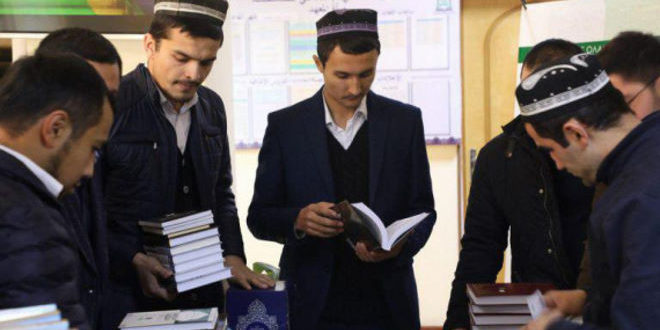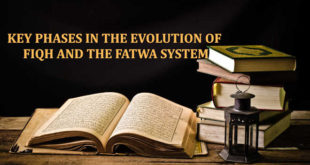It is well known that Allah sent down the Holy Qur’an to the Prophet (pbuh) to explain it to humanity, how to follow its instructions, to show people the rules of action, and to convey to people other rulings that are not mentioned in the Qur’an. Allah says in this regard:
بِالْبَيِّنَاتِ وَالزُّبُرِ وَأَنْزَلْنَا إِلَيْكَ الذِّكْرَ لِتُبَيِّنَ لِلنَّاسِ مَا نُزِّلَ إِلَيْهِمْ وَلَعَلَّهُمْ يَتَفَكَّرُونَ
Meaning: “With clear signs and books. And We have sent down to you the Reminder, that you may make clear to mankind what has been revealed to you. Hopely, they will understand”[1]
This means that the words of the Prophet (peace and blessings of Allah be upon him) are also a Shari‘a source, with special emphasis on the words of the Prophet (peace and blessings of Allah be upon him). It is inevitably to comprehend the Shari‘a essence without his words.
The Messenger of Allah himself pointed to this and said:
Malik ibn Anas reported: The Messenger of Allah (may peace be upon him) said: I am leaving two things among you. As long as you hold these two things together, you’ll never go wrong. They said, ‘The Book of Allah and the Sunnah of His Messenger’. It is narrated in Muvatto mournfully. [2]
The Companions who understood the instructions of the Messenger of Allah (peace and blessings of Allah be upon him) should study the words of Prophet with all their effect and not miss any of his words.
Occasionally, they are determined to embark on long and difficult journeys in the name of a single hadith. The emphasis on the study of hadiths has subsequently been passed onto the Taba’in, from those of the Taba’een, and thus to the later generations. Although the development of the science of hadith has been around since the time of the Companions to the present day, scholars mention the previous three centuries in this regard. For these, three centuries of hadith have a special place in science.
The first century was the age of the Companion sand the Great Tawheed. This century was the century of learning the meanings of hadith, what verdict can be found from them and paying attention to the harmony with Ayahs in Qur’an.
The study of hadith had not yet begun at that time. Because this century was so close to the Messenger of Allah and the people of that time were so infinitesimal about religion, there is no need to distinguish the trustworthiness of the hadiths, and there is no need to elaborate certain rules.
This period was the time of the Companions and the Great Tawheed. In the second century, the need to test the authenticity of hadiths began. As far as the Messenger of Allah (peace and blessings of Allah be upon him) was concerned, people’s savings had begun to change. The piety of the people of this period was not the same as the piety of the companions and the followers.
Also, in the second century, a number of superstitious sects emerged, trying to prove their claims from various hadiths. This would require, first of all, the examination of all hadiths concerning the Prophet (peace be upon him) and the separation of trustworthy hadiths from their trust. This led to several directions related to the science of sanad science, narrators and other hadiths.
Therefore, this period was the time when the emergence of hadith terms and rules and the establishment of hadith schools. Developed the foundations of this science by Abdullah ibn Mubarak, Malik ibn Anas, Sufyan al-Savri, Sufyan bin Uyayna, Yahya ibn Said al-Qattan, Abdurrahman ibn Mahdi, Yahya ibn Ma’in, Waki’ Anrah, Amr ibn Ali Fallas, Ali Ibn Madini and others. Scholars who created the principles of science were related to the second century.
The third century was the age of collecting hadiths based on the rules and methods developed in the earlier century, separating them from unreliable beliefs, examining all of the hadiths and texts, and sorting them into books.
A number of scholars have appeared in this field and have written works, and some scholars have surpassed others in this regard. Examples include Abu Bakr ibn Abu Shayba, Humaidi, Abdurrazzak, Imam Muslim and many others. However, in this century, no scholar has succeeded in reaching the level of Muhammad ibn Ismail al-Bukhari in the above work.
After all, it is recognized by all scholars that it is unique in all aspects of the science of hadith. Especially, the confession of Imam al-Bukhari’s mentors needs the praise of his peers and students.
Imam Bukhari’s skillful implementation of the rules of investigation of hadiths and writing a compelling collection have led him to become even more famous and to be recognized as “Amir al-Mu’minin of Hadith science” – “The leader of the believers in hadith science .” Scholars have testified that his work is the most reliable book between the Heavens and the Earth after the Qur’an.
Recognizing the authentic collections of Imam Bukhari as the most reliable collection has attracted the attention of all scholars of hadith. He wrote reviews, commentaries, the information about narrators and books in about thirty different directions.
After all, Ibn Hajar Asqalani, a scholar who lived in the eighth century B.C. and received the title “Amir of the Believers in the science of hadith” wrote twenty-five volumes of commentary on “Sahihul Bukhari” and said that there were twenty-eight books written by Imam Bukhari in the preface. The fact that his comments are over a hundred, and that the comments are still in place today, is a clear indication.
The work is a masterpiece in the science of hadith, and it is used as a textbook in all the world’s religious educational institutions. At the Tashkent Islamic institute named after Imam al-Bukhari, the third and fourth- year- students are taught by textbooks fully. After all, the Institute has several grounds for choosing “Sahihul Bukhari” as a textbook. They are:
– the “Sahihul Bukhari” book is the most reliable of all the hadiths. Hence, it is desirable to use this subject as a textbook in the science of hadith. After all, in any subject, students should be given the most reliable of science information.
– the author of the work was our ancestor. After all, it is both a task and a duty for us to study the heritage of our ancestors.
– because the work is a masterpiece in hadith science, it is also used as a textbook in the most prestigious religious educational institutions in the world.
– President Shavkat Mirziyoyev has repeatedly said to experts in the field that it is necessary to deeply study the works of our ancestors and educate the younger generation based on their rich heritage.
There is another important aspect that should not be overlooked as a textbook. It is well known that the work was not written on a particular sect. Rather, the hadiths there are in accordance with Imam al-Bukhari’s conditions for introducing hadiths, as well as the hadiths that have been established by scholars of hadith. This led to the fact that not all the hadiths in the work were exactly compatible with a particular sect.
In addition, the complexity of the title and the captioning of Imam al-Bukhari’s own judgments of the hadiths require careful handling of the work.
People in our country have been living in the Hanafi madhhab since ancient times, and fatwas have been given according to this sect, and religious studies have always been taught in the Hanafi school books.
Here are a number of important things that you can do at the Tashkent Islamic institute named after Imam al-Bukhari at the same time:
- Several hadiths in the work are cited as evidence in the Hanafi madhhab. The students are told how the hadiths are evidence for the Hanafi madhhab.
- Students have difficulty understanding the hadiths in the work, their “translation of the unit”, that is, the headings of the hadith. After all, many hadith scholars have recognized that “Sahihul Bukhari” is more difficult than other works for students to use.
- Imam Bukhari is said to be a mujtahid of scholars. This is evident in the title of the hadith. Of course, the book contains a number of hadith titles that are not compatible with the Hanafi madhhab on a number of issues. Students should be told in these headings what Imam Bukhari has to say and what is the issue in the Hanafi madhhab.
- It is also no secret that in recent times, there is an increase in the number of those who judge directly from the hadith without following any sect. They say, “If the hadith is authentic, we will act on it” and the trustworthy hadith collects directly from the works such as “Sahih al-Bukhari” and “Sahih Muslim”. This is a situation that also creates some complications and conflicts between people.
The Tashkent Islamic Institute aims to educate people who can resist them and explain the Hanafi madhhab, which is a moderate denomination to the people, along with rational evidence, the Quran and hadiths, and at the same time give strong and well-grounded refusal to wrong people. As a practical confirmation of this, the Institute has been teaching the students the interpretation of “Sahihul Bukhari” in the Hanafi madhhab.
- There is an important reason why the work is carried out in the Institute in its entirety. After all, those who are influenced by foreign ideas, who speaks misleading things, and who does not follow a particular sect and who, without sufficient knowledge, attempt to obtain evidence from the hadiths themselves, generally present evidence from reliable collections.
The students of the Institute study such hadith books as “Sahihul Bukhari” and “Sunani Termizi” in the Hanafi madhhab in order to provide students with the necessary immunity to them and give them reasoned refusals.
In this way, they will examine the evidence for the Hanafi madhhab in the work and why the hadiths that are not evidence for the Hanafi madhhab are not accepted in our madhhabs, and what evidence they have in Qur’an and other hadiths as opposed to these hadiths and become an experienced specialist in this field.
Students become one-sided if they do not read the whole book, read the selection of the work, or collect the hadiths and read only the hadiths that are evidence for the Hanafi school. As a result, when confronted with hadiths that do not appear to be evidence for the Hanafi madhhab, but appear to contradict it, he cannot know what to say or refutes it even if he refuses. This can have negative consequences.
The conclusion is that “Sahihul Bukhari” is an unprecedented work. We are proud of that the author is our ancestor. That is why we can study the work, interpret the hadiths to the younger generation in accordance with our sect, supply the spirituality of the people by this, give a reasonable refusal to those who misinterpret the work, and at the same time be a role model for all those who study Imam Bukhari’s “Sahihul Bukhari” is our commitment.
- The Holy Quran. – Tashkent: “Khilol-nashr” Publishing, 2019.
- Khatib Tabrizi. Mishkotul masabih. – Beirut: Dorul- fikr, 1991.
- Muhammad ibn Ismail Bukhari. Sahih al-Bukhari. – Beirut: Publisher ar-treatise, 2019.
- Abu Isa Tirmidhi. Sunan at-Tirmidhi. – Beirut: Dor ul Garb al Islami, 1996.
- Abu Dawud Sijistani. Sunan Abu Dawud. – Beirut: Dorur treatise al-Alamiya, 2009.
- Malik ibn Anas. Muvatto. – Beirut: Dor Ihyo at-Turos al-Araby, 2018.
- Nuriddin Itr. Manhajun nakd.— Beirut: Dorul -Fikr, 2010.
- Muhammad ibn Abdullah Hakim. Mustadrak alas sahihayn. – Beirut: Dar al-Qudil Science, 2002.
- Zafar Ahmed Osmaniy. The hadith is a well-known one. – Karachi: Ioratul Qur’an wa ullamil Islam, 2009.
 Imom Buxoriy xalqaro ilmiy-tadqiqot markazi bukhari.uz
Imom Buxoriy xalqaro ilmiy-tadqiqot markazi bukhari.uz












